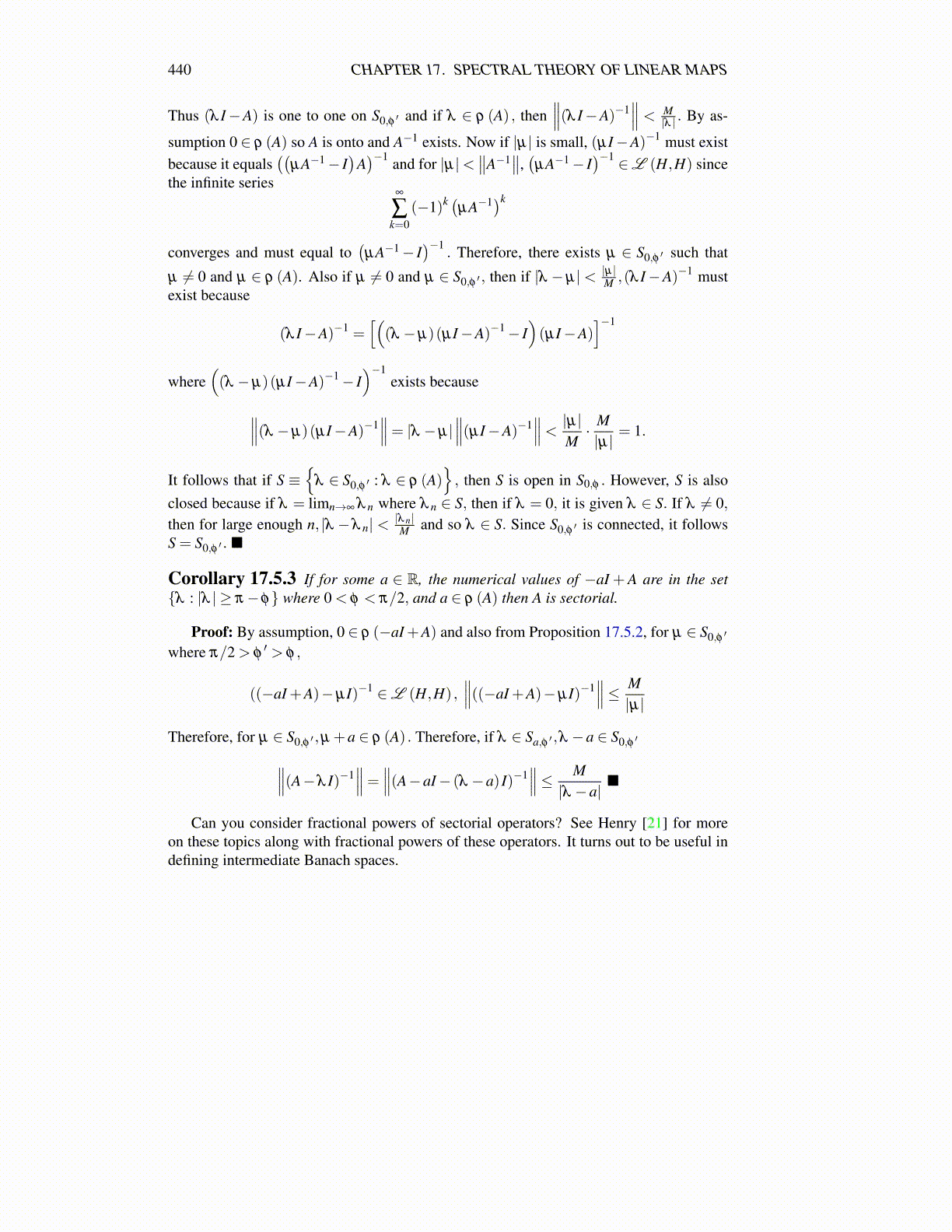
440 CHAPTER 17. SPECTRAL THEORY OF LINEAR MAPS
Thus (λ I−A) is one to one on S0,φ ′ and if λ ∈ ρ (A) , then∥∥∥(λ I−A)−1
∥∥∥ < M|λ | . By as-
sumption 0 ∈ ρ (A) so A is onto and A−1 exists. Now if |µ| is small, (µI−A)−1 must existbecause it equals
((µA−1− I
)A)−1 and for |µ|<
∥∥A−1∥∥,(µA−1− I
)−1 ∈L (H,H) sincethe infinite series
∞
∑k=0
(−1)k (µA−1)k
converges and must equal to(µA−1− I
)−1. Therefore, there exists µ ∈ S0,φ ′ such that
µ ̸= 0 and µ ∈ ρ (A). Also if µ ̸= 0 and µ ∈ S0,φ ′ , then if |λ −µ| < |µ|M ,(λ I−A)−1 must
exist because
(λ I−A)−1 =[(
(λ −µ)(µI−A)−1− I)(µI−A)
]−1
where((λ −µ)(µI−A)−1− I
)−1exists because
∥∥∥(λ −µ)(µI−A)−1∥∥∥= |λ −µ|
∥∥∥(µI−A)−1∥∥∥< |µ|
M· M|µ|
= 1.
It follows that if S ≡{
λ ∈ S0,φ ′ : λ ∈ ρ (A)}, then S is open in S0,φ . However, S is also
closed because if λ = limn→∞ λ n where λ n ∈ S, then if λ = 0, it is given λ ∈ S. If λ ̸= 0,then for large enough n, |λ −λ n| < |λ n|
M and so λ ∈ S. Since S0,φ ′ is connected, it followsS = S0,φ ′ . ■
Corollary 17.5.3 If for some a ∈ R, the numerical values of −aI +A are in the set{λ : |λ | ≥ π−φ} where 0 < φ < π/2, and a ∈ ρ (A) then A is sectorial.
Proof: By assumption, 0 ∈ ρ (−aI +A) and also from Proposition 17.5.2, for µ ∈ S0,φ ′
where π/2 > φ′ > φ ,
((−aI +A)−µI)−1 ∈L (H,H) ,∥∥∥((−aI +A)−µI)−1
∥∥∥≤ M|µ|
Therefore, for µ ∈ S0,φ ′ ,µ +a ∈ ρ (A) . Therefore, if λ ∈ Sa,φ ′ ,λ −a ∈ S0,φ ′∥∥∥(A−λ I)−1∥∥∥= ∥∥∥(A−aI− (λ −a) I)−1
∥∥∥≤ M|λ −a|
■
Can you consider fractional powers of sectorial operators? See Henry [21] for moreon these topics along with fractional powers of these operators. It turns out to be useful indefining intermediate Banach spaces.